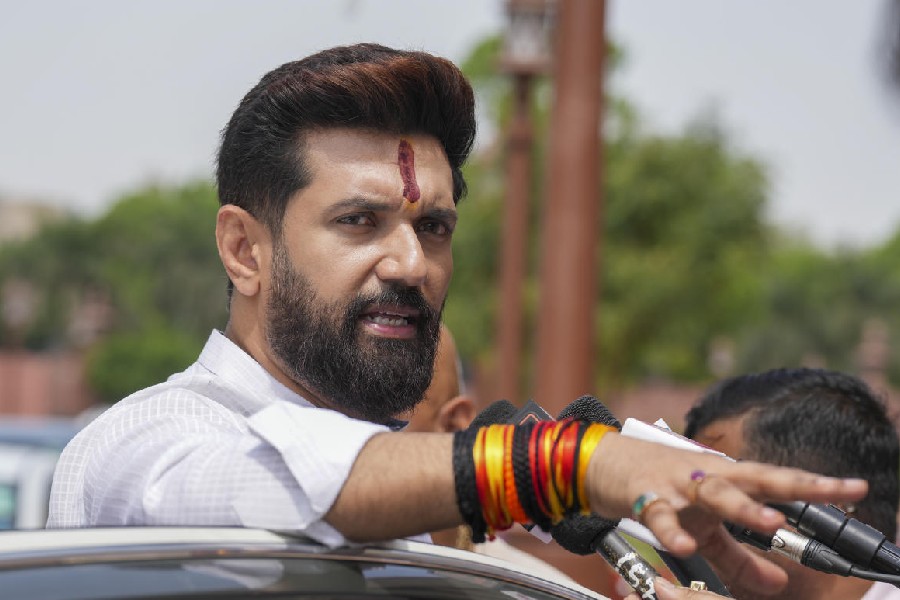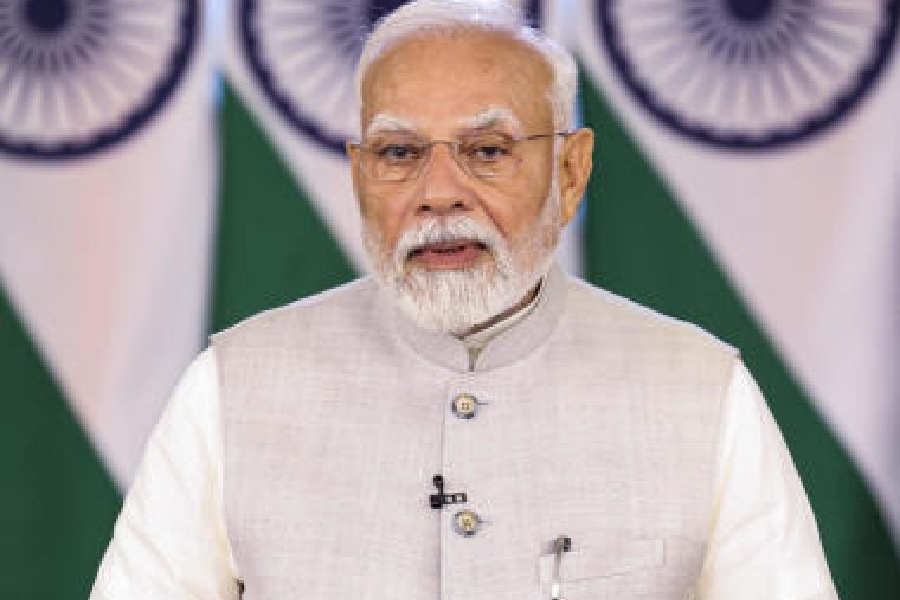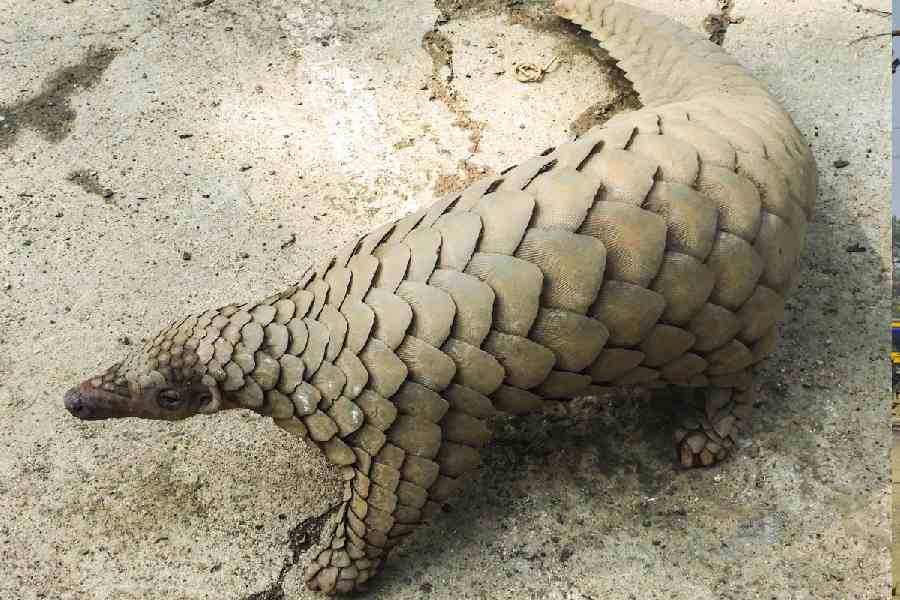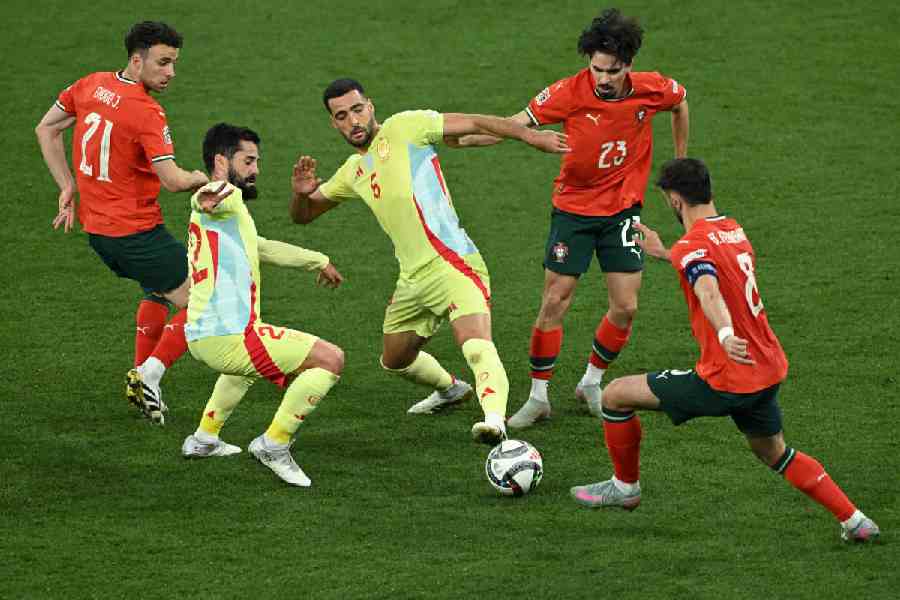 |
| NEW ROAD, OLD WAYS: A man hitches a perilous ride atop a three-wheeler on north Bihar’s spanking highway. Picture by Sankarshan Thakur |
For more than an aching decade — strangely, or not so strangely, those years coincided with the Lalu-Rabri raj — the British era bridge across the turbulent Gandak lay snapped like an old man’s sundered ribs. Rusted beyond repair, the superannuated ironwork gave way during one torrential monsoon during the mid-1990s and became a gnarled mess piled on either bank. The river span suddenly gaped. Those that used the crossing — thousands and thousands to and fro each day between this vast rural hinterland and the townships of Darbhanga, Muzaffarpur and even Patna — had a crossing no more. What was a two-minute ride from one flank of the Gandak to the other became an odyssey of wading and trudging, cattle-like. And when the river exploded in monsoon, invading its banks, boats were the only way.
But that, happily for the journeymen of this road that runs, arrow-like, into Nepal, was then.
Now, you get to Jale — on the Indo-Nepal border in Darbhanga — in less than half an hour, forking north at the Atarbel crossroads from the Golden Quadrilateral that’s abridging time and distance in these parts with a djinn’s prowess.
It’s four-lane dual carriageway, leaping up and down gargantuan underpasses, a 21st century blaze cutting across what’s mostly 19th century India.
The quadrilateral is an anachronism to behold, a massive marvel of engineering pasted on a landscape still mired in insufficiency.
On either side of it lies country that is still mostly tilled by animal hoof and human hand. Clusters of unlit habitation. Barebodied fishermen who trawl mucky water-bodies, fykes in hand.
Vegetable growers who walk miles each day, heavy baskets balanced precariously on their heads, to hawk their wares in village haats.
Loose grain merchants pushing sack-laden carts and cycles, sweating, struggling, unable to fetch speed or comfort that such a highway affords the motorised traveller. Trucks and buses zoom by, littering the road with the shrill report of their horns. The big cars, you barely even sight them as they clip past. Even little autorickshaws, shaky of carriage and short of horsepower, have begun to feed their masters bigger fruit.
“I would do two, at a crush three, passenger trips between Jale and Atarbel a day before this road was built and I was done,” says Kishan Kamti, a three-wheeler driver. “Now I do eight, sometimes even ten, makkhan hai, this road’s like butter.”
You’d sometimes wonder on this road why politicians — the central dramatis personae of this election hour — continue to prefer flying to driving, like it was in the old days. The ground, after all, is what they are competing to hold; the ground is what they’ve forsaken more and more for airier ways. But the road’s a gift of value that far outweighs the netas’ indifference to it. Ask the people, of any political hue or leaning for politics does dominate the current discourse, and they’d tell. Ramadhar Rai, for instance, is a devoted Lalu Prasad votary, a Yadav by caste who is nostalgic about what he calls “Yadav raj” (the Lalu-Rabri years). He’s political preference is nobody’s secret, but neither is the credit he hands out rather willingly to chief minister Nitish Kumar.
“Kaam to kiyen hain, Nitishbabu, yeh baat alag hai ki hum unko apna vote nahin de sakte hain, lekin badlav hua hai, sadak hi dekhiye. (Nitish has put in work, it’s another matter that my vote isn’t his, but change has happened, look at the road itself).”
Such is the road that brings you to Jale, one-time boondock rippling with the first intimations of boom. You cross the Gandak and you scarcely even notice what used to be the hardship stretch; there’s a new bridge, a gentle hump of concrete that deposits you this side or that of the river in the wink of an eye. Onward on the macadam to Jale from where you can make that most rare international passage: by rickshaw into Nepal, a twenty-rupee, half-hour ride, no passport required.
It’s only when you’ve gone beyond the border that the road turns rugged and begins to disintegrate; this side of the non-existent fence, it’s a surf so smooth some have actually begun to complain, as complaining people are wont to.
“Aafat”, old Mian Mohiuddin calls the new road, calamity itself! From his distended little dawakhana in Jale’s one-lane market to the mosque used to be a carefree walk. Now, it’s a daily hazard he braces himself for each time he departs and returns; and being devout, the old man must brave it five times a day.
“Paagalon ki tarah chalate hain chikni sadak par, sadak na hui jahannum ho gaya, chill-poon, chill-poon har waqt. (They drive like mad on this smooth road, it’s become hell, this road, cacophony all day long).”
But old Mian Mohiuddin is a bit of a bygone relic, the subject of happy mockery in the Jale bazaar; “sanki” they call him in colloquial, a loveable crank. “This road has transformed our lives, whatever Mianji might say,” exults Badri Sau in the old man’s face.
Sau’s his neighbour, owner of an all-goods store, who has expanded his trade manifold during the last couple of years. “Goods arrive cheaper, fresher, faster thanks to this road,” Sau says. “And we are on the border, Nepal this side, Bihar that side, import-export, import-export, quickly-quickly.”
He could well have added “money-money” too, but the thrill in his tone was enough, and the fact that the Sau business proclaims itself from several shopfronts in the market. “Baniya hain na, sir, maal bana rahe hain, khush hain.” Sau’s a trader by caste, after all, money is music.
As we departed, he invited us to look out for his house at the far edge of town, where Jale’s semi-urban trail ends and the countryside takes over. “It is the big one to your left,” Sau called out, “you can’t miss it.” We couldn’t even if we tried. It was floor upon floor piled up on a match-box plot, painted parrot green, awnings rimmed in orange, doors and windows crimson. Whenever you see colour, think of Badri Sau.
But what colour he was politically Sau wouldn’t directly reveal. We asked and we asked, and he wove rings and rings around us. It’s a multi-cornered contest, there are many claimants, people are making up their minds, let us see, et al, consummate and practiced aversion from commitment. “I’d say only one thing,” he offered, almost as a concession to a passing scribe. “There is visible change and people are feeling it. Enough for you to add two and two.”
That could make four, or given Bihar’s endemic complexities of caste and creed, even five.











